Bearded Species for Breeding Arilbred Medians |
This article originally appeared in Aril Society International
Special Publication 2011-2014.
Bearded Species for Breeding
Arilbred Medians
The smaller arilbreds, usually called arilbred medians or aril-medians, have been a popular type of iris for many decades. Just as medians fill different garden niches than do TBs, adding diversity of size, form, and pattern to an iris collection, so do arilbred medians extend the usefulness and interest of the arilbreds. Some gardeners find the arilbred medians more adaptable than their larger cousins. The popularity of these small arilbreds is well established: recipients of the William Mohr medal are as likely as not to be arilbred medians.
Although arilbred medians can result from many different types of cross, the "classic" cross for arilbred medians is SDB x OGB, standard dwarf x amphidiploid arilbred. The reasons for this are obvious. Both parental types are fully fertile, widely and easily grown, and have become very refined in appearance and popular.
Unfortunately, arilbred medians produced in this way suffer from some limitations. Being unbalanced tetraploids, they have little or no fertility, making it effectively impossible to "carry on the line" of a promising seedling. Furthermore, these irises are only ¼ aril, and so do not show their aril heritage in the dramatic and varied ways the half-aril tall arilbreds do.
Is it possible to breed a whole race of small arilbreds that are fertile halfbreds?
Theory tells us the answer is yes; in fact, two different such races are possible. In practice, progress in this promising undertaking has been slow and spotty.
The reasons are several. First and foremost, these fertile arilbred medians will come from crossing tetraploid arils with tetraploid dwarfs and medians. Tetraploid arils, like all pure arils, are not widely grown. And the tetraploid dwarf and median irises (species and garden hybrids) are much less widely grown than the ubiquitous SDBs. Whereas many hybridizers have ready access to hundreds of SDBs and OGBs, very few have access to a range of tetraploid arils and (for example) Iris pumila forms. Secondly, producing the fertile arilbred medians and arilbred dwarfs involves going back to species and near-species hybrids that show few of the modern refinements expected in new introductions. Hence, a number of generations are required before the results can compare with the overall quality of a good SDB x OGB cross. Finally, there are only a few people actively hybridizing arilbreds at present, and most have their own projects and priorities that do not involve expanding these fertile families.
Nevertheless, I hope more hybridizers will take up the challenge and make at least some crosses that have the potential of producing the fertile arilbred medians and arilbred dwarfs of the future. It is my hope that this article may inspire a few people to give these crosses a try.
Before discussing the bearded iris species that may be used, a few words should be said about tetraploid arils. For this kind of breeding, arilbreds are no help. Pure arils are needed, and they must be tetraploid, which rules out all the oncocyclus species as well as Iris korolkowii (which are diploid). The Regelia species Iris hoogiana and Iris stolonifera are natural tetraploids, as are some Regelia hybrids, notably 'Bronze Beauty Van Tubergen' and 'Vera'. Early tetraploid arils with oncocyclus content include 'Persian Pansy', 'Tel Hashi', 'Werckmeister's Beauty', and 'Dunshanbe' (all are regeliocycli). John Holden and Sam Norris collaborated to produce tetraploid oncogelias by using the chemical colchicine to induce chromosome doubling. A few of these are still being grown (more in Europe than in the US, it seems). Lawrence Ransom used a Norris seedling to produce the tetraploid RCs 'Tadzhiki Bandit' and 'Tadzhiki Eclipse' (both introduced in 1997). Since the extraordinary work of Holden and Norris is unlikely to be reproduced any time soon, it is imperative that we make an effort to preserve and propagate these tetraploid oncogelias and use them to breed more tetraploid arils.
 |
 |
 |
|
|
|
|
Although some may feel that they cannot grow pure arils at all, it should be noted that the Regelias and RCs are regarded as much easier than the oncocycli. I encourage everyone to try a Regelia or two in their garden; you may be surprised with success!
It must be stressed that the bearded species discussed below have potential for producing fertile offspring only when crossed with tetraploid pure arils. Crossing them with arilbreds, for example, offers no advantage over the SDB x OGB cross or other similar approaches.
The first of the two families of small fertile arilbreds is the arilpums. These result from crossing tetraploid arils with Iris pumila. So far, only two have been registered and introduced into commerce: 'Barbarella' (Mathes '91) and 'Aladdin's Gem' (Thoolen '02). Both have considerable oncocyclus ancestry. Over the years, other arilpums have been produced by Peter Werckmeister, John Tearington, Elm Jensen, Lawrence Ransom, and others; and of course Mathes and Thoolen produced a number that were not introduced.
Because Iris pumila is the tiniest of tetraploid bearded species, these arilpums are truly miniaturized arilbreds. Most fall in the height range of the MDB and SDB classes. They also typically bloom well in advance of the taller arilbreds. Being so small, they occupy quite a special niche in the garden. Their Iris pumila ancestry also confers some adaptability to cold-winter climates.
 |
 |
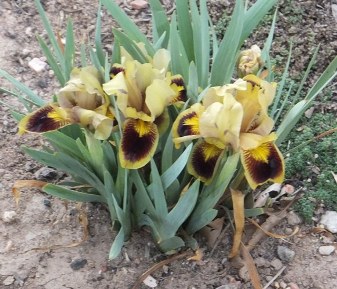 |
|
|
|
|
The work of Mathes and Thoolen was curtailed because their arilpums, although they bear fertile pollen, are extremely reluctant pod parents. The reason for this is not understood, although it is apparently more a physiological barrier than a chromosomal one (which would equally affect the pollen). I note that pod-infertility was a problem with early tall arilbreds (e. g., 'Capitola') and some early regeliocycli. I conjecture that what is needed is to raise many aril x pumila seedlings from many different parental types, and make crosses with them persistently until a consistently fertile line is developed.
Iris pumila has an extravagent range of variation in color and form. Even though it is the only species likely to be useful in developing the arilpum family (unless the similar Iris taurica and Iris alexeenkoi are regarded as separate species), its own diversity promises that the family will not be lacking in variety. Wild-collected forms sometimes offered in seed exchanges and from the list of collectors are especially valuable, representing new genetic material different from our named garden cultivars.
The second family has a chromosome configuration that is essentially the same as the "C. G. White type" amphidiploid arilbreds: two sets of 10 or 11 aril chromosomes and two sets of 12 bearded iris chromosomes. If the bearded iris chromosomes come from a small bearded species rather than a TB, arilbreds of median height are the expected result. Most importantly, arilbred medians in this family are not only fertile amongst themselves, but fertile with the tall OGB halfbreds, opening up great possibilities for bringing the qualities of the well-developed OGB class into a series of smaller plants.
For developing this family, we have a number of bearded species to choose from.
Iris aphylla is a small but copiously branched species from eastern Europe. It is behind the ancestry of most black or intensely violet TB irises. Except for the branching, it seems unimpressive to the eye accustomed to modern median irises. The substance is weak, and the petals are narrow and typically of a rather non-descript violet color. Perhaps it would be a good match with regelias, whose narrowness is admired as elegant?
Iris aphylla was used to create today's tetraploid MTBs. This work was pioneered by Ben Hager and carried on with much success by Jim and Vicki Craig. (There are also some IBs and BBs from these lines.) It would seem quite a good idea to breed these refined aphylla descendents with tetraploid arils for arilbred medians. If the goal is truly to create small arilbreds, care should be taken to use small parents and select small arilbred offspring, especially if these are to be crossed with their tall arilbred counterparts to bring in their advanced form and coloring.
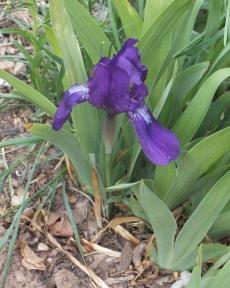 |
 |
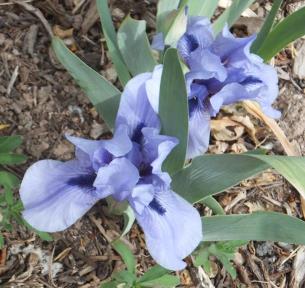 |
|
|
|
|
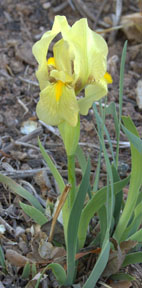 Another
bearded species with potential in breeding this family is the Balkan
species Iris reichenbachii (photo at left). The species is
famous in TB breeding for having been the source of the modern
dominant amoena pattern through the efforts of Paul Cook. The
conundrum is that this species comes in both diploid and tetraploid
forms, and it seems the tetraploid forms are now rare in cultivation.
When I began working with irises in the 1970s, the smoky violet form
of Iris reichenbachii that was called Iris balkana was
widely available and exclusively tetraploid. There were also a number
of collected clones of yellow Iris reichenbachii that had been
counted as tetraploid. It would be nice if some true tetraploid forms
could be identified and propagated, since this is the smallest
tetraploid bearded iris with chromosomes in sets of 12. It thus has
potential for creating truly diminutive arilbreds.
Another
bearded species with potential in breeding this family is the Balkan
species Iris reichenbachii (photo at left). The species is
famous in TB breeding for having been the source of the modern
dominant amoena pattern through the efforts of Paul Cook. The
conundrum is that this species comes in both diploid and tetraploid
forms, and it seems the tetraploid forms are now rare in cultivation.
When I began working with irises in the 1970s, the smoky violet form
of Iris reichenbachii that was called Iris balkana was
widely available and exclusively tetraploid. There were also a number
of collected clones of yellow Iris reichenbachii that had been
counted as tetraploid. It would be nice if some true tetraploid forms
could be identified and propagated, since this is the smallest
tetraploid bearded iris with chromosomes in sets of 12. It thus has
potential for creating truly diminutive arilbreds.
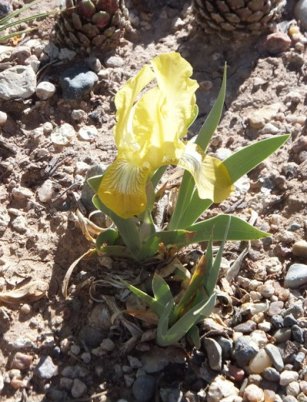 Writing
in the 1998 Yearbook, Harald Mathes called attention to Iris
schachtii from Turkey, a confirmed tetraploid which had recently
become available at that time (photo at right). This species is
variable in flower color, branching, and overall size. The smaller
forms are no larger than Iris reichenbachii, and many forms
are generously branched. Today, this species is probably the single
most important resource for the breeding of this fertile family. A
few different forms of Iris schachtii and a few different
tetraploid arils would make an excellent basis for a breeding
program.
Writing
in the 1998 Yearbook, Harald Mathes called attention to Iris
schachtii from Turkey, a confirmed tetraploid which had recently
become available at that time (photo at right). This species is
variable in flower color, branching, and overall size. The smaller
forms are no larger than Iris reichenbachii, and many forms
are generously branched. Today, this species is probably the single
most important resource for the breeding of this fertile family. A
few different forms of Iris schachtii and a few different
tetraploid arils would make an excellent basis for a breeding
program.
These other species from Turkey, also noted in Mathes's article, are also tetraploids and could also be used. They are not so easy to obtain as Iris schachtii, and being of larger size are perhaps less suitable if the goal is specifically small arilbreds.
The genetic legacy of the diploid bearded species Iris suaveolens is already present in our fertile arilbreds. Harald Mathes crossed it with a diploid aril, and treated the seedling with colchicine to produce a fertile tetraploid. Crossing this seedling with a conventional arilbred produced 'Anacrusis', which is thus half aril and ¼ Iris suaveolens. 'Anacrusis' and its descendants inherited a smaller stature than other OGB arilbreds because of this dwarf bearded ancestry. It is a testimony to the potential of such creative breeding programs that an 'Anacrusis' descendant, 'Concerto Grosso', was awarded the C. G. White medal in 2005. If the CGW family is expanded using any of the bearded species described above, crossing the seedlings with 'Anacrusis' and its descendants provides a way of reinforcing the dwarf ancestry without compromising flower quality.
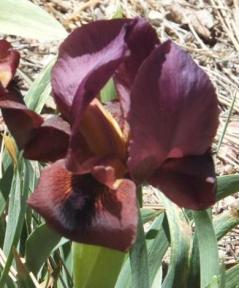 |
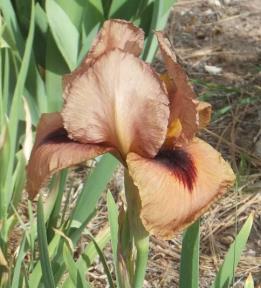 |
 |
|
|
|
|
I have focused on the tetraploid arils and tetraploid bearded irises because crossing them is the most direct way to produce irises in these two fertile families. However, diploids, triploids, and unbalanced tetraploids can also play a role in this project, if one is willing to persist in making crosses in the hope of an infrequent successful pollination. A full discussion of how these plants can contribute to the two fertile families outlined above is beyond the scope of this article.
There is always something to be gained by stepping outside theory and making experimental crosses, even if it is just to learn what happens when you do. This article has emphasized the direct approach, because I think the potential there is clear and largely untapped to date.
I imagine a time when our gardens will include arilbreds spanning the whole range of size we see in the bearded irises, MDB to TB. Many will be fertile, half aril, and adaptable to a wide range of climates. There will still be ¼ aril arilbred medians, of course, but also perhaps small OGB+ irises from arilbred median breeding. The arilbreds of the future will carry the genes of many bearded species, not just a few.
It's not a project for the impatient, but pioneers like Werckmeister, Mathes, and Thoolen have already shown the way and made the first leg of the journey for us. With a modicum of effort, anyone can collect a few tetraploid arils and a few of the bearded species mentioned in this article and start making crosses.
February 2015
|
|
Unless otherwise noted, all text and illustrations copyright Tom Waters and all photographs copyright Tom or Karen Waters. Please do not reproduce without permission.